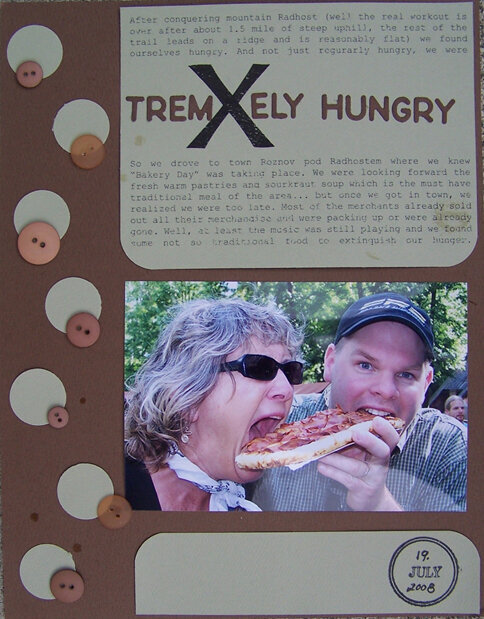
Take an extra 9% OFF with code: LOVE

 Give a Cheer
Give a Cheer
Front page:
After conquering mountain Radhost (well the real workout is over after about 1.5 mile of steep uphill, the rest of the trail leads on a ridge and is reasonably flat) we found ourselves hungry. And not just regularly hungry, we were extremely hungry. So we drove to town Roznov pod Radhostem where we knew “Bakery Day” was taking place. We were looking forward the fresh warm pastries and sauerkraut soup which is the must have traditional meal of the area... but once we got in town, we realized we were too late. Most of the merchants already sold out all their merchandise and were packing up or were already gone. Well, at least the music was still playing and we found some not so traditional food to extinguish our hunger.
Taped to the back:
Rožnov pod Radhoštěm – the heart of Wallachia
Rožnov is a sort of miniature Wallachia, at least as far as it concerns the history of its settlement. It was founded in the period of the first farming colonization in the 13th century. From the 16th century clearings began to be made on the foothills and in the mountains around the town which then formed two separate settlements, Dolní and Horní Paseky, in the valleys near two mountain streams. And finally shepherds´ huts began to appear above Rožnov on Mt. Radhošť, Mt. Černá and Bača´s hill.
In the 19th Rožnov had only 3,000 inhabitants and was notable perhaps only for the fact that the people kept strictly to the traditional way of life, determined by the poorness of the region as well as other factors. The original lay-out of the town square was preserved with its forty wooden two-storeyed houses joined at the front by picturesque arcades.
It was also in the 19th century when the ancient wooden town of Rožnov became a reputable spa. Its therapeutic means were the excellent climatic conditions which helped patients with “sick lungs” and warm sheep whey which was separated of sheep cheese and produced in huts on the mountain sides. The sheep were milked in the evening and soon after midnight the shepherds from Radhošť Mount, Bača´s hill and other places set out for their daily round, carrying from ten to twenty litres of sheep whey on their backs, to sell it in Rožnov before daybreak. Then the spa guests wandered through the park with beakers of fresh sweet whey, taking deep breaths of the moist resined air. They came to Rožnov from all over Central Europe, above all from the Austria-Hungeria Empire. There were famous people walking through the spa colonnade, such as Sigmund Freud, the founder of psychoanalysis, or Johann Gregor Mendel, the founder of genetics.
The spa brought with it a rise in the culture of the town. A large spa park was created and later a spa house, and a spa orchestra played in the park and on the square. In 1862 one of the first choir in Moravia,called the Tetřev chorus, was founded in there. Rožnov townsmen became dissatisfied with their wooden houses and replaced them with stone buildings, luckily not all of them. There were people who could not bear to destroy the old buildings, and thus the idea of the Wallachian Museum was born.
Today Rožnov pod Radhoštěm is an important centre of tourism and vacationing in the Moravian-Silesian Beskydy Mountains. The town and its surroundings provide a lot of opportunities for tourism- hiking, skiing, swimming with a wide range of accommodation and catering possibilities. The town is situated on the E-442 Road of European Classifikation. It is linked by buslines with the whole country. Railway transport from Rožnov is provided through the important railway junction of Valašské Meziříčí .Even an air transport facility is easy to reach.The airport Mošnov is 40 km far from Rožnov on the route to Ostrava. The town is called the heart of Wallachia and „the gate“ to the Moravian-Silesian Beskydy Mountains.
Thanks for spreading positivity!
September 04, 2008
September 04, 2008
August 19, 2008
August 15, 2008
August 14, 2008
August 12, 2008
August 12, 2008
August 12, 2008
August 11, 2008
August 11, 2008
August 11, 2008
August 10, 2008
August 10, 2008
August 10, 2008
August 10, 2008
August 10, 2008
August 10, 2008
August 09, 2008
August 09, 2008
August 09, 2008